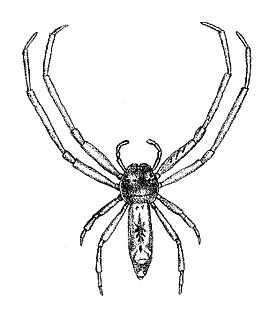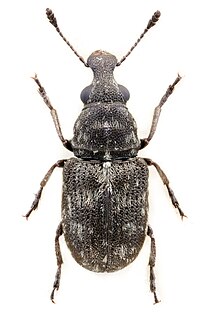
The Thomisidae are a family of spiders, including about 170 genera and over 2,100 species. The common name crab spider is often linked to species in this family, but is also applied loosely to many other families of spiders. Many members of this family are also known as flower spiders or flower crab spiders.

The Pholcidae are a family of araneomorph spiders. The family contains over 1,800 individual species of pholcids, including those commonly known as cellar spider, daddy long-legs spider, carpenter spider, daddy long-legger, vibrating spider, gyrating spider, long daddy, and skull spider. The family, first described by Carl Ludwig Koch in 1850, is divided into 94 genera.

Chionoecetes is a genus of crabs that live in the northern Pacific and Atlantic Oceans.

Carl Alexander Clerck was a Swedish entomologist and arachnologist.

Episinus angulatus is a small mottled brownish tangle-web spider, found from Europe to Russia.

Tmarus is a genus of crab spiders, comprising the following species:

Senecio angulatus, also known as creeping groundsel and Cape ivy, is a succulent flowering plant in the family Asteraceae that is native to South Africa. Cape ivy is a scrambling and a twining herb that can become an aggressive weed once established, making it an invasive species. It has been naturalised in the Mediterranean Basin, where it is grown as an ornamental plant for its satiny foliage and sweet-scented flowers.
Mirosternus angulatus is a species of beetle in the family Ptinidae.
Foliatus, a Latin word meaning leafy, may refer to:

Araneus angulatus is a species of orb-weaving spiders found in the Palearctic realm. It resembles the European garden spider, Araneus diadematus, but has distinctive tubercles on its abdomen. The species was first described in Aranei Svecici in 1757, where it was the first species described, making Araneus angulatus the first scientific name of an animal that is still in use.
Semljicola angulatus is a spider species found in Scandinavia, Russia, Mongolia and Sakhalin.
Oryphantes is a genus of dwarf spiders that was first described by J. E. Hull in 1932.
Ischnocerus angulatus is a species of fungus weevil in the beetle family Anthribidae.
Scaphinotus angulatus is a species of ground beetle in the family Carabidae. It is found in North America.
Dicheirus dilatatus is a species of ground beetle in the family Carabidae. It is found in North America.

Allandrus is a genus of fungus weevils in the beetle family Anthribidae. There are about nine described species in Allandrus.
Acinopterus angulatus, the angulate leafhopper, is a species of leafhopper in the family Cicadellidae.
Paccius is a genus of African araneomorph spiders first described by Eugène Simon in 1898 as a member of Corinnidae, and moved to Trachelidae in 2014.

Tmarus piger is a species of crab spider belonging to the family Thomisidae.












